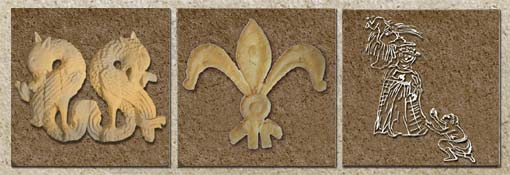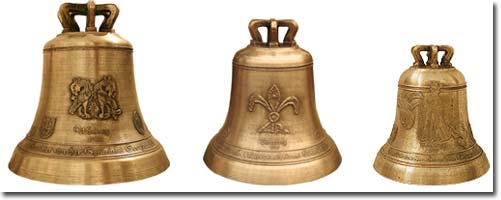The triead bells in Georgenthal
At the beginning of the 20th century owned the Elisabethkirche a bronze triad bells. Prof. Dr. P. Lehfeld described it in 1898 in a book about Thuringian art monuments as followed:
"1) Poured by Karl Friedrich Ulrich in Apolda in 1887, as of emperor Wilhelm I of had completed his 90th anniversary among Germany´s jubilation.
2) in 1825 from Jac. Bitorf in Seligenthal, with badly poured, but interesting thought baizes and with relief rich in figure of the crucifixion on the skin surface.
3) in 1893 while the funereal ringing for Herzog Ernst II chapped, from brothers Ulrich in Apolda repoured."
The First World War let those witnesses of the past become silent; the ringing was melted and the material got from it was used for war purposes and tools. Only in 1924 the bells in Georgenthal again called for the prayer. Indeed, these were, the need owed, iron bells whose value life span was already estimated up to 70 to 90 years at that time.
After the quiescence of one of those bells aound 2004 the wish for a new ringing grew in Georgenthal. Nevertheless, such a great financial effort could not be mastered only by the parish. Fortunately, the district councillors decided in 2007 to support the bell project with about 20,000 Euros and to make therefore the dream of the new ringing generally come true. It is to be owed to the founder's mind of many citizens of this town that also the remaining, still missing amount could be raised. All together the investment for the new carillon amounted up to 35,000 Euros.
To consecrate the ringing for the anniversary year of the patroness Elisabeth, asked for an optical revaluation of three bells, being adequate to the event, The liturgical function of the baptismal bell, the prayer bell and the eternity bell was made clear in the form of reliefs which show the actions of the mercy on the front of the bells. To hit a spiritual curve from Georgenthal to the life and places of work of the saints Elisabeth, the connection to the Wartburg, to the castle Creutzburg as well as to Marburg was transformed (see picture, from left to right: Wartburg-Kapitell, castle Creutzburg, Marburg).
These connections symbolise in each case back-sided on the baptismal bell (faith) the relief of the Elisabeth bell from Marburg (1330), on the prayer bell (love) the relief of a French lily (symbol of the Cistercians, unites the virtues of cleanness and mild activity) from the "Elisabethkemenate" of the castle Creutzburg as well as on the eternity bell (hope) the imprint of a Romanesque capital of the Wartburg. These reliefs were modeled as models in wax, afterwards they were raised in clay as a negative on the "wrong" bell and they were finally prepared for the pour..

back


